The Professional Practice
VerifiedAdded on 2022/08/27
|11
|1939
|18
AI Summary
Contribute Materials
Your contribution can guide someone’s learning journey. Share your
documents today.
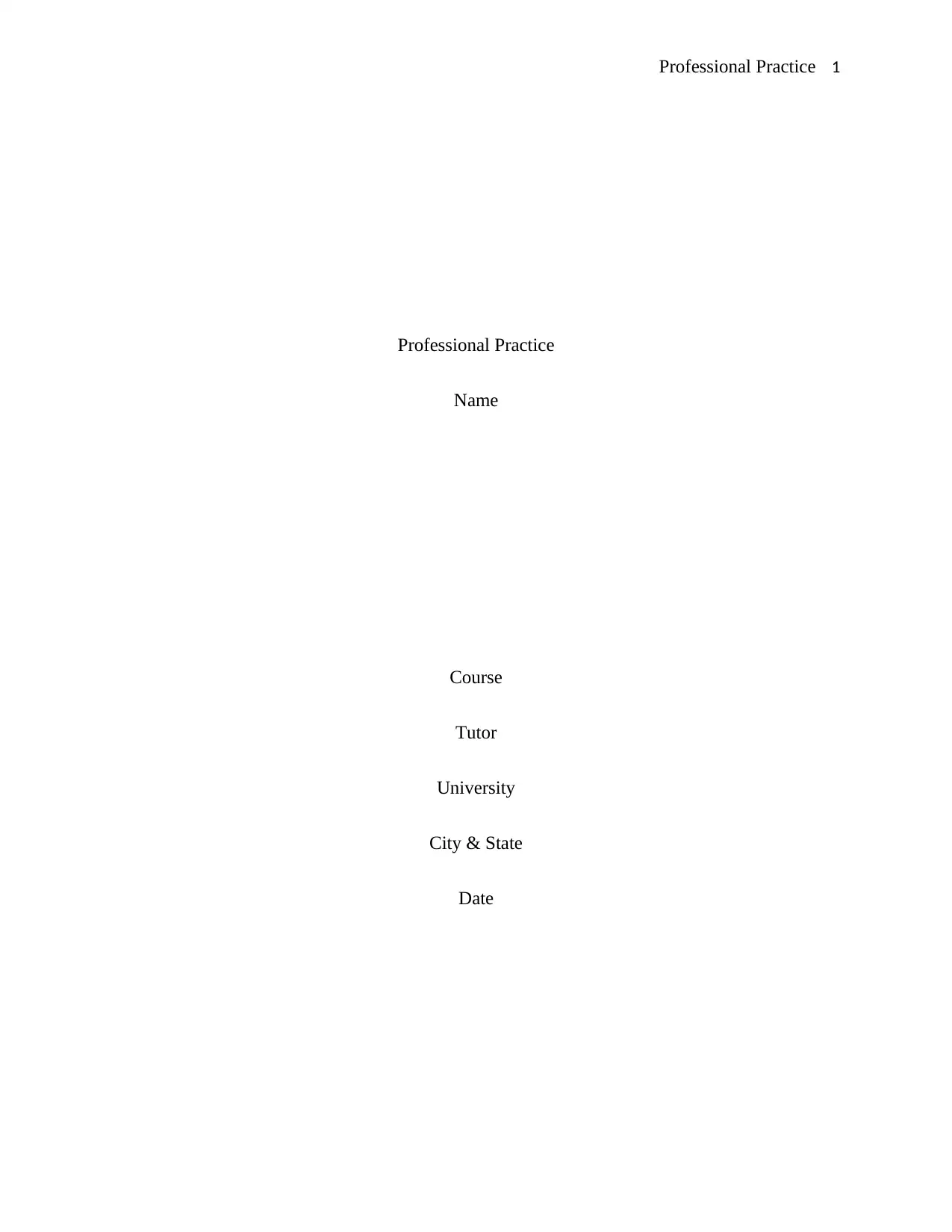
Professional Practice 1
Professional Practice
Name
Course
Tutor
University
City & State
Date
Professional Practice
Name
Course
Tutor
University
City & State
Date
Secure Best Marks with AI Grader
Need help grading? Try our AI Grader for instant feedback on your assignments.
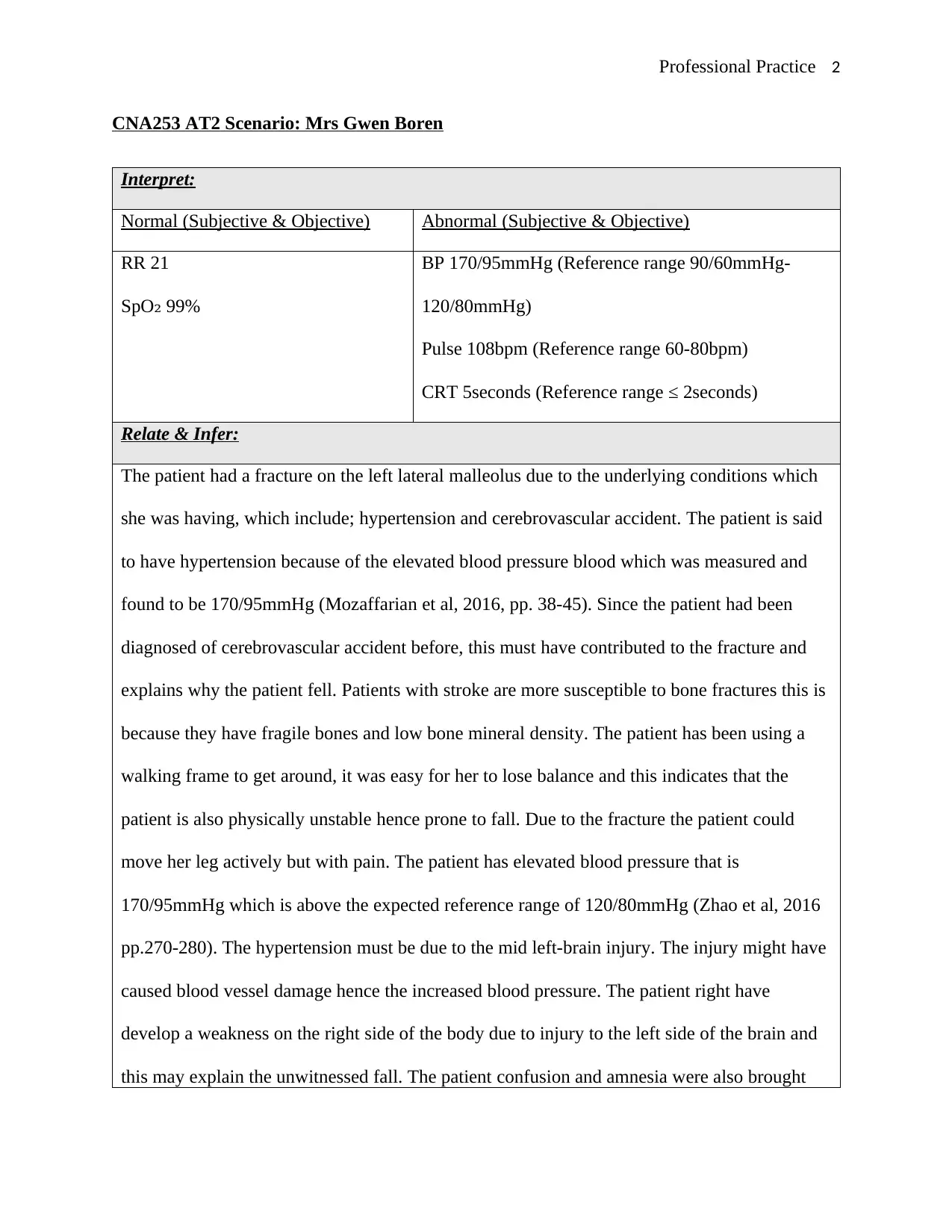
Professional Practice 2
CNA253 AT2 Scenario: Mrs Gwen Boren
Interpret:
Normal (Subjective & Objective) Abnormal (Subjective & Objective)
RR 21
SpO 99%₂
BP 170/95mmHg (Reference range 90/60mmHg-
120/80mmHg)
Pulse 108bpm (Reference range 60-80bpm)
CRT 5seconds (Reference range ≤ 2seconds)
Relate & Infer:
The patient had a fracture on the left lateral malleolus due to the underlying conditions which
she was having, which include; hypertension and cerebrovascular accident. The patient is said
to have hypertension because of the elevated blood pressure blood which was measured and
found to be 170/95mmHg (Mozaffarian et al, 2016, pp. 38-45). Since the patient had been
diagnosed of cerebrovascular accident before, this must have contributed to the fracture and
explains why the patient fell. Patients with stroke are more susceptible to bone fractures this is
because they have fragile bones and low bone mineral density. The patient has been using a
walking frame to get around, it was easy for her to lose balance and this indicates that the
patient is also physically unstable hence prone to fall. Due to the fracture the patient could
move her leg actively but with pain. The patient has elevated blood pressure that is
170/95mmHg which is above the expected reference range of 120/80mmHg (Zhao et al, 2016
pp.270-280). The hypertension must be due to the mid left-brain injury. The injury might have
caused blood vessel damage hence the increased blood pressure. The patient right have
develop a weakness on the right side of the body due to injury to the left side of the brain and
this may explain the unwitnessed fall. The patient confusion and amnesia were also brought
CNA253 AT2 Scenario: Mrs Gwen Boren
Interpret:
Normal (Subjective & Objective) Abnormal (Subjective & Objective)
RR 21
SpO 99%₂
BP 170/95mmHg (Reference range 90/60mmHg-
120/80mmHg)
Pulse 108bpm (Reference range 60-80bpm)
CRT 5seconds (Reference range ≤ 2seconds)
Relate & Infer:
The patient had a fracture on the left lateral malleolus due to the underlying conditions which
she was having, which include; hypertension and cerebrovascular accident. The patient is said
to have hypertension because of the elevated blood pressure blood which was measured and
found to be 170/95mmHg (Mozaffarian et al, 2016, pp. 38-45). Since the patient had been
diagnosed of cerebrovascular accident before, this must have contributed to the fracture and
explains why the patient fell. Patients with stroke are more susceptible to bone fractures this is
because they have fragile bones and low bone mineral density. The patient has been using a
walking frame to get around, it was easy for her to lose balance and this indicates that the
patient is also physically unstable hence prone to fall. Due to the fracture the patient could
move her leg actively but with pain. The patient has elevated blood pressure that is
170/95mmHg which is above the expected reference range of 120/80mmHg (Zhao et al, 2016
pp.270-280). The hypertension must be due to the mid left-brain injury. The injury might have
caused blood vessel damage hence the increased blood pressure. The patient right have
develop a weakness on the right side of the body due to injury to the left side of the brain and
this may explain the unwitnessed fall. The patient confusion and amnesia were also brought
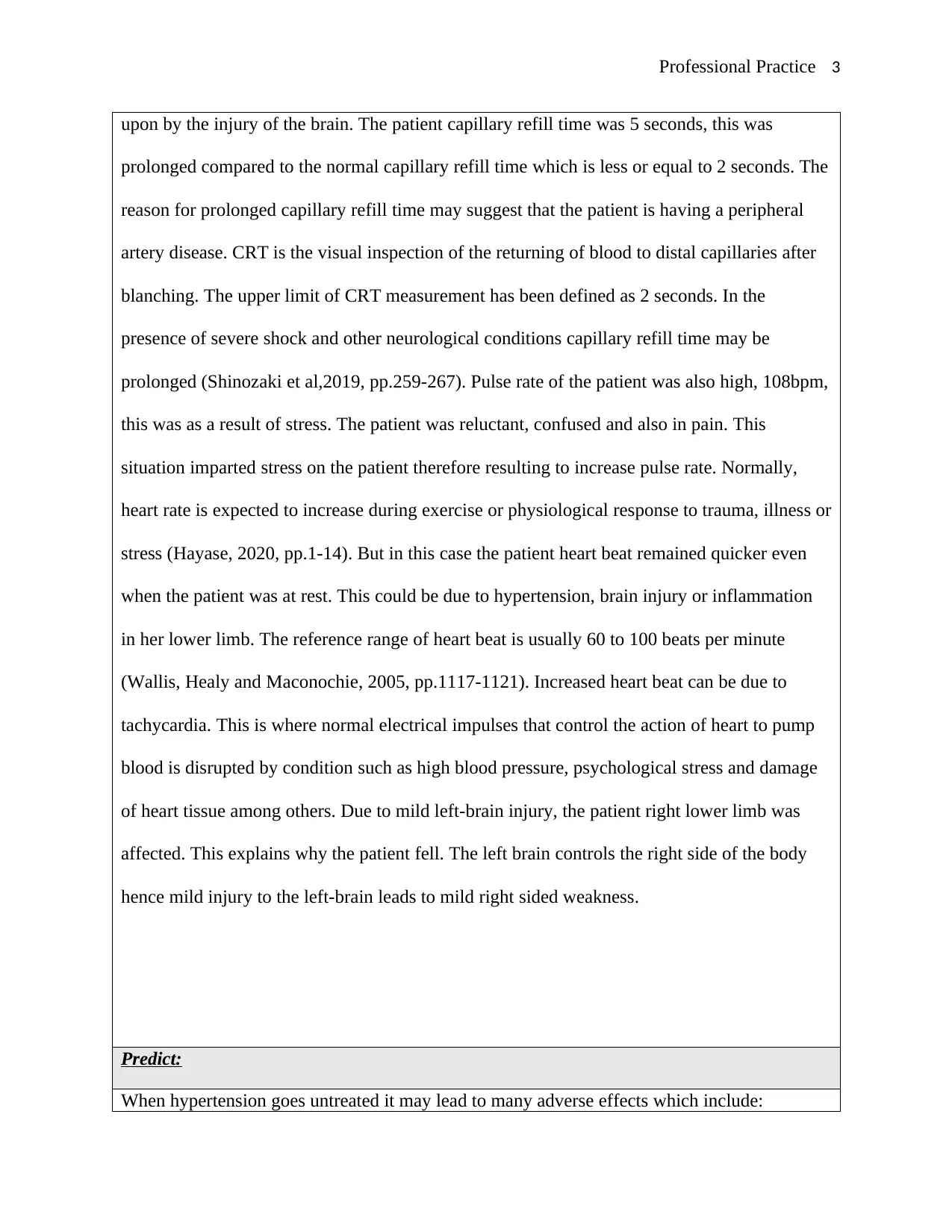
Professional Practice 3
upon by the injury of the brain. The patient capillary refill time was 5 seconds, this was
prolonged compared to the normal capillary refill time which is less or equal to 2 seconds. The
reason for prolonged capillary refill time may suggest that the patient is having a peripheral
artery disease. CRT is the visual inspection of the returning of blood to distal capillaries after
blanching. The upper limit of CRT measurement has been defined as 2 seconds. In the
presence of severe shock and other neurological conditions capillary refill time may be
prolonged (Shinozaki et al,2019, pp.259-267). Pulse rate of the patient was also high, 108bpm,
this was as a result of stress. The patient was reluctant, confused and also in pain. This
situation imparted stress on the patient therefore resulting to increase pulse rate. Normally,
heart rate is expected to increase during exercise or physiological response to trauma, illness or
stress (Hayase, 2020, pp.1-14). But in this case the patient heart beat remained quicker even
when the patient was at rest. This could be due to hypertension, brain injury or inflammation
in her lower limb. The reference range of heart beat is usually 60 to 100 beats per minute
(Wallis, Healy and Maconochie, 2005, pp.1117-1121). Increased heart beat can be due to
tachycardia. This is where normal electrical impulses that control the action of heart to pump
blood is disrupted by condition such as high blood pressure, psychological stress and damage
of heart tissue among others. Due to mild left-brain injury, the patient right lower limb was
affected. This explains why the patient fell. The left brain controls the right side of the body
hence mild injury to the left-brain leads to mild right sided weakness.
Predict:
When hypertension goes untreated it may lead to many adverse effects which include:
upon by the injury of the brain. The patient capillary refill time was 5 seconds, this was
prolonged compared to the normal capillary refill time which is less or equal to 2 seconds. The
reason for prolonged capillary refill time may suggest that the patient is having a peripheral
artery disease. CRT is the visual inspection of the returning of blood to distal capillaries after
blanching. The upper limit of CRT measurement has been defined as 2 seconds. In the
presence of severe shock and other neurological conditions capillary refill time may be
prolonged (Shinozaki et al,2019, pp.259-267). Pulse rate of the patient was also high, 108bpm,
this was as a result of stress. The patient was reluctant, confused and also in pain. This
situation imparted stress on the patient therefore resulting to increase pulse rate. Normally,
heart rate is expected to increase during exercise or physiological response to trauma, illness or
stress (Hayase, 2020, pp.1-14). But in this case the patient heart beat remained quicker even
when the patient was at rest. This could be due to hypertension, brain injury or inflammation
in her lower limb. The reference range of heart beat is usually 60 to 100 beats per minute
(Wallis, Healy and Maconochie, 2005, pp.1117-1121). Increased heart beat can be due to
tachycardia. This is where normal electrical impulses that control the action of heart to pump
blood is disrupted by condition such as high blood pressure, psychological stress and damage
of heart tissue among others. Due to mild left-brain injury, the patient right lower limb was
affected. This explains why the patient fell. The left brain controls the right side of the body
hence mild injury to the left-brain leads to mild right sided weakness.
Predict:
When hypertension goes untreated it may lead to many adverse effects which include:
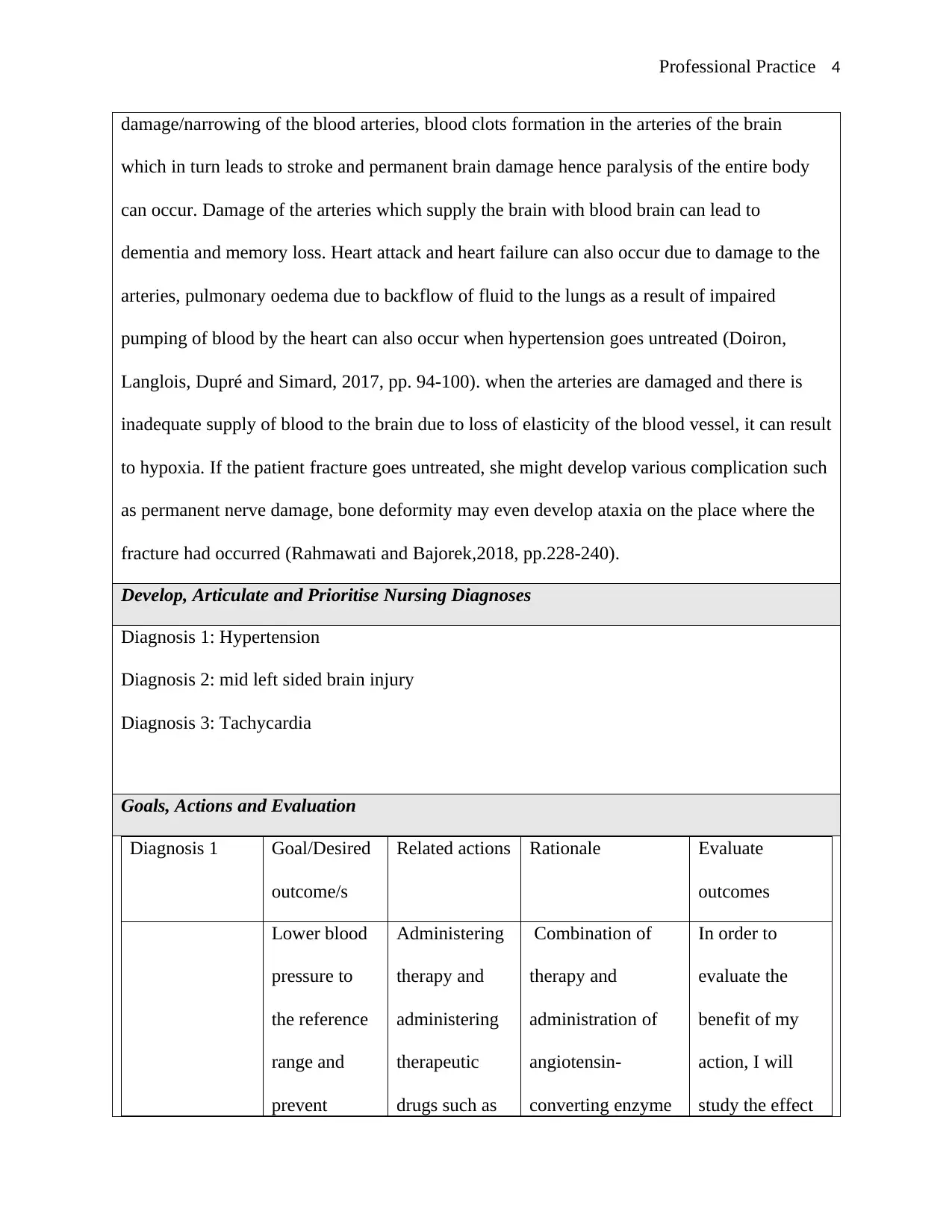
Professional Practice 4
damage/narrowing of the blood arteries, blood clots formation in the arteries of the brain
which in turn leads to stroke and permanent brain damage hence paralysis of the entire body
can occur. Damage of the arteries which supply the brain with blood brain can lead to
dementia and memory loss. Heart attack and heart failure can also occur due to damage to the
arteries, pulmonary oedema due to backflow of fluid to the lungs as a result of impaired
pumping of blood by the heart can also occur when hypertension goes untreated (Doiron,
Langlois, Dupré and Simard, 2017, pp. 94-100). when the arteries are damaged and there is
inadequate supply of blood to the brain due to loss of elasticity of the blood vessel, it can result
to hypoxia. If the patient fracture goes untreated, she might develop various complication such
as permanent nerve damage, bone deformity may even develop ataxia on the place where the
fracture had occurred (Rahmawati and Bajorek,2018, pp.228-240).
Develop, Articulate and Prioritise Nursing Diagnoses
Diagnosis 1: Hypertension
Diagnosis 2: mid left sided brain injury
Diagnosis 3: Tachycardia
Goals, Actions and Evaluation
Diagnosis 1 Goal/Desired
outcome/s
Related actions Rationale Evaluate
outcomes
Lower blood
pressure to
the reference
range and
prevent
Administering
therapy and
administering
therapeutic
drugs such as
Combination of
therapy and
administration of
angiotensin-
converting enzyme
In order to
evaluate the
benefit of my
action, I will
study the effect
damage/narrowing of the blood arteries, blood clots formation in the arteries of the brain
which in turn leads to stroke and permanent brain damage hence paralysis of the entire body
can occur. Damage of the arteries which supply the brain with blood brain can lead to
dementia and memory loss. Heart attack and heart failure can also occur due to damage to the
arteries, pulmonary oedema due to backflow of fluid to the lungs as a result of impaired
pumping of blood by the heart can also occur when hypertension goes untreated (Doiron,
Langlois, Dupré and Simard, 2017, pp. 94-100). when the arteries are damaged and there is
inadequate supply of blood to the brain due to loss of elasticity of the blood vessel, it can result
to hypoxia. If the patient fracture goes untreated, she might develop various complication such
as permanent nerve damage, bone deformity may even develop ataxia on the place where the
fracture had occurred (Rahmawati and Bajorek,2018, pp.228-240).
Develop, Articulate and Prioritise Nursing Diagnoses
Diagnosis 1: Hypertension
Diagnosis 2: mid left sided brain injury
Diagnosis 3: Tachycardia
Goals, Actions and Evaluation
Diagnosis 1 Goal/Desired
outcome/s
Related actions Rationale Evaluate
outcomes
Lower blood
pressure to
the reference
range and
prevent
Administering
therapy and
administering
therapeutic
drugs such as
Combination of
therapy and
administration of
angiotensin-
converting enzyme
In order to
evaluate the
benefit of my
action, I will
study the effect
Secure Best Marks with AI Grader
Need help grading? Try our AI Grader for instant feedback on your assignments.
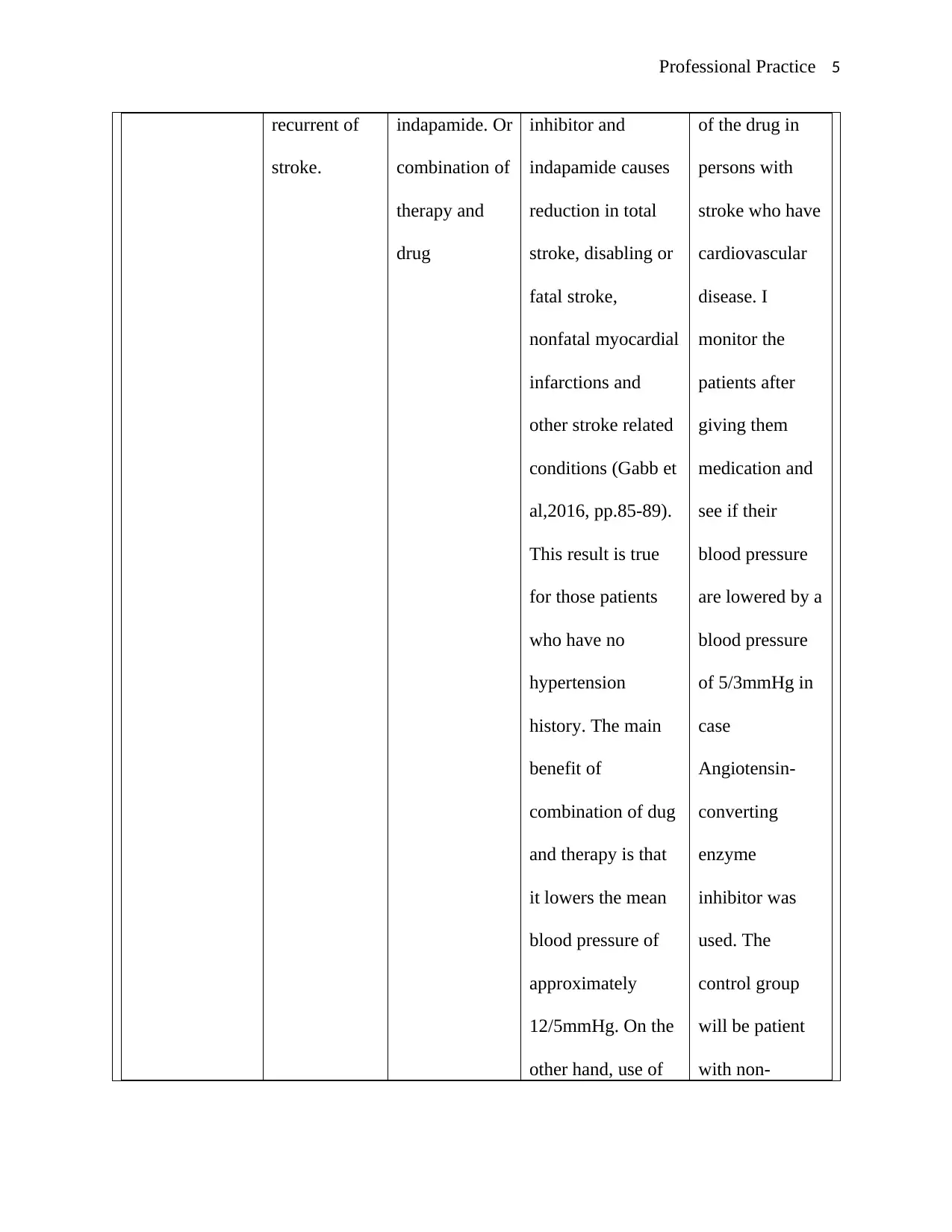
Professional Practice 5
recurrent of
stroke.
indapamide. Or
combination of
therapy and
drug
inhibitor and
indapamide causes
reduction in total
stroke, disabling or
fatal stroke,
nonfatal myocardial
infarctions and
other stroke related
conditions (Gabb et
al,2016, pp.85-89).
This result is true
for those patients
who have no
hypertension
history. The main
benefit of
combination of dug
and therapy is that
it lowers the mean
blood pressure of
approximately
12/5mmHg. On the
other hand, use of
of the drug in
persons with
stroke who have
cardiovascular
disease. I
monitor the
patients after
giving them
medication and
see if their
blood pressure
are lowered by a
blood pressure
of 5/3mmHg in
case
Angiotensin-
converting
enzyme
inhibitor was
used. The
control group
will be patient
with non-
recurrent of
stroke.
indapamide. Or
combination of
therapy and
drug
inhibitor and
indapamide causes
reduction in total
stroke, disabling or
fatal stroke,
nonfatal myocardial
infarctions and
other stroke related
conditions (Gabb et
al,2016, pp.85-89).
This result is true
for those patients
who have no
hypertension
history. The main
benefit of
combination of dug
and therapy is that
it lowers the mean
blood pressure of
approximately
12/5mmHg. On the
other hand, use of
of the drug in
persons with
stroke who have
cardiovascular
disease. I
monitor the
patients after
giving them
medication and
see if their
blood pressure
are lowered by a
blood pressure
of 5/3mmHg in
case
Angiotensin-
converting
enzyme
inhibitor was
used. The
control group
will be patient
with non-
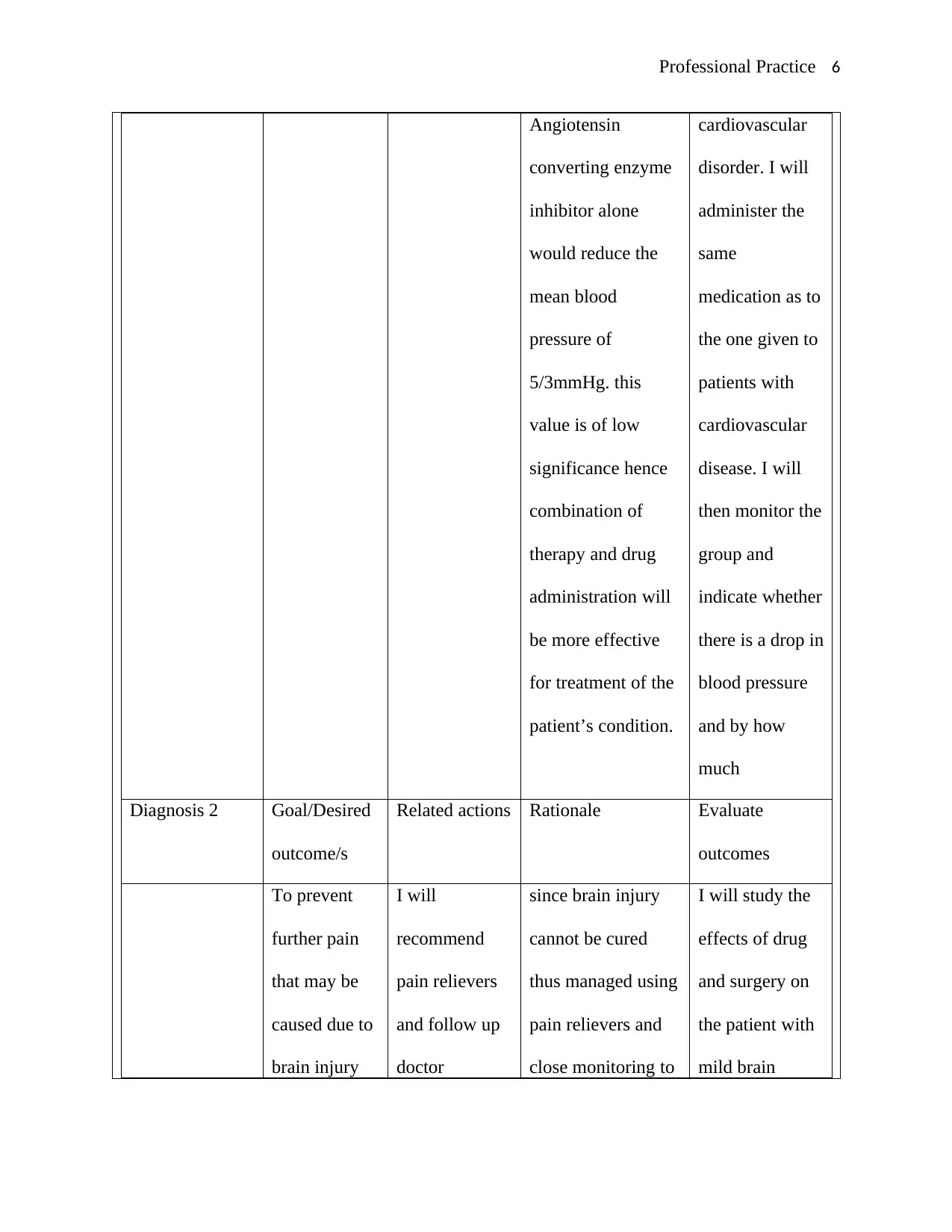
Professional Practice 6
Angiotensin
converting enzyme
inhibitor alone
would reduce the
mean blood
pressure of
5/3mmHg. this
value is of low
significance hence
combination of
therapy and drug
administration will
be more effective
for treatment of the
patient’s condition.
cardiovascular
disorder. I will
administer the
same
medication as to
the one given to
patients with
cardiovascular
disease. I will
then monitor the
group and
indicate whether
there is a drop in
blood pressure
and by how
much
Diagnosis 2 Goal/Desired
outcome/s
Related actions Rationale Evaluate
outcomes
To prevent
further pain
that may be
caused due to
brain injury
I will
recommend
pain relievers
and follow up
doctor
since brain injury
cannot be cured
thus managed using
pain relievers and
close monitoring to
I will study the
effects of drug
and surgery on
the patient with
mild brain
Angiotensin
converting enzyme
inhibitor alone
would reduce the
mean blood
pressure of
5/3mmHg. this
value is of low
significance hence
combination of
therapy and drug
administration will
be more effective
for treatment of the
patient’s condition.
cardiovascular
disorder. I will
administer the
same
medication as to
the one given to
patients with
cardiovascular
disease. I will
then monitor the
group and
indicate whether
there is a drop in
blood pressure
and by how
much
Diagnosis 2 Goal/Desired
outcome/s
Related actions Rationale Evaluate
outcomes
To prevent
further pain
that may be
caused due to
brain injury
I will
recommend
pain relievers
and follow up
doctor
since brain injury
cannot be cured
thus managed using
pain relievers and
close monitoring to
I will study the
effects of drug
and surgery on
the patient with
mild brain
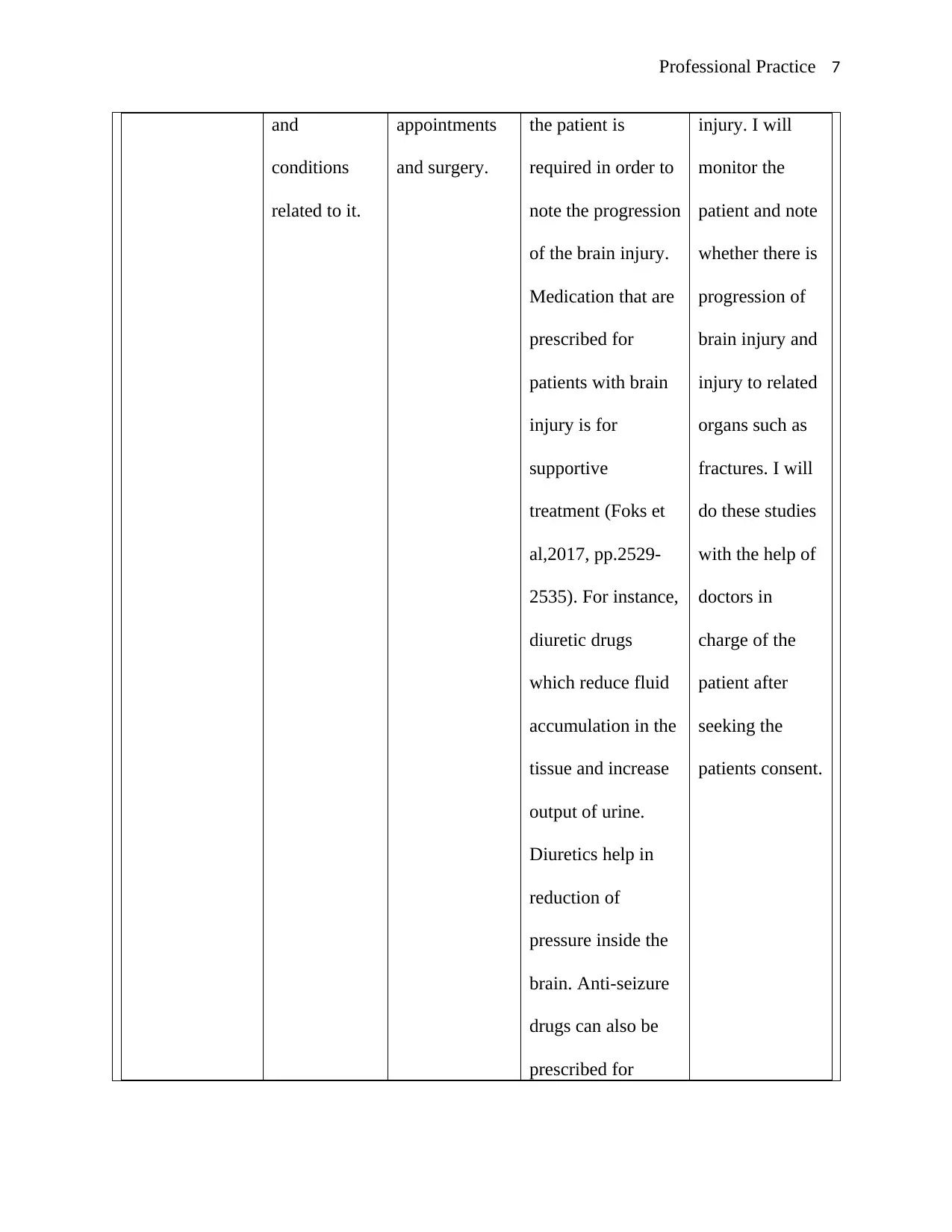
Professional Practice 7
and
conditions
related to it.
appointments
and surgery.
the patient is
required in order to
note the progression
of the brain injury.
Medication that are
prescribed for
patients with brain
injury is for
supportive
treatment (Foks et
al,2017, pp.2529-
2535). For instance,
diuretic drugs
which reduce fluid
accumulation in the
tissue and increase
output of urine.
Diuretics help in
reduction of
pressure inside the
brain. Anti-seizure
drugs can also be
prescribed for
injury. I will
monitor the
patient and note
whether there is
progression of
brain injury and
injury to related
organs such as
fractures. I will
do these studies
with the help of
doctors in
charge of the
patient after
seeking the
patients consent.
and
conditions
related to it.
appointments
and surgery.
the patient is
required in order to
note the progression
of the brain injury.
Medication that are
prescribed for
patients with brain
injury is for
supportive
treatment (Foks et
al,2017, pp.2529-
2535). For instance,
diuretic drugs
which reduce fluid
accumulation in the
tissue and increase
output of urine.
Diuretics help in
reduction of
pressure inside the
brain. Anti-seizure
drugs can also be
prescribed for
injury. I will
monitor the
patient and note
whether there is
progression of
brain injury and
injury to related
organs such as
fractures. I will
do these studies
with the help of
doctors in
charge of the
patient after
seeking the
patients consent.
Paraphrase This Document
Need a fresh take? Get an instant paraphrase of this document with our AI Paraphraser
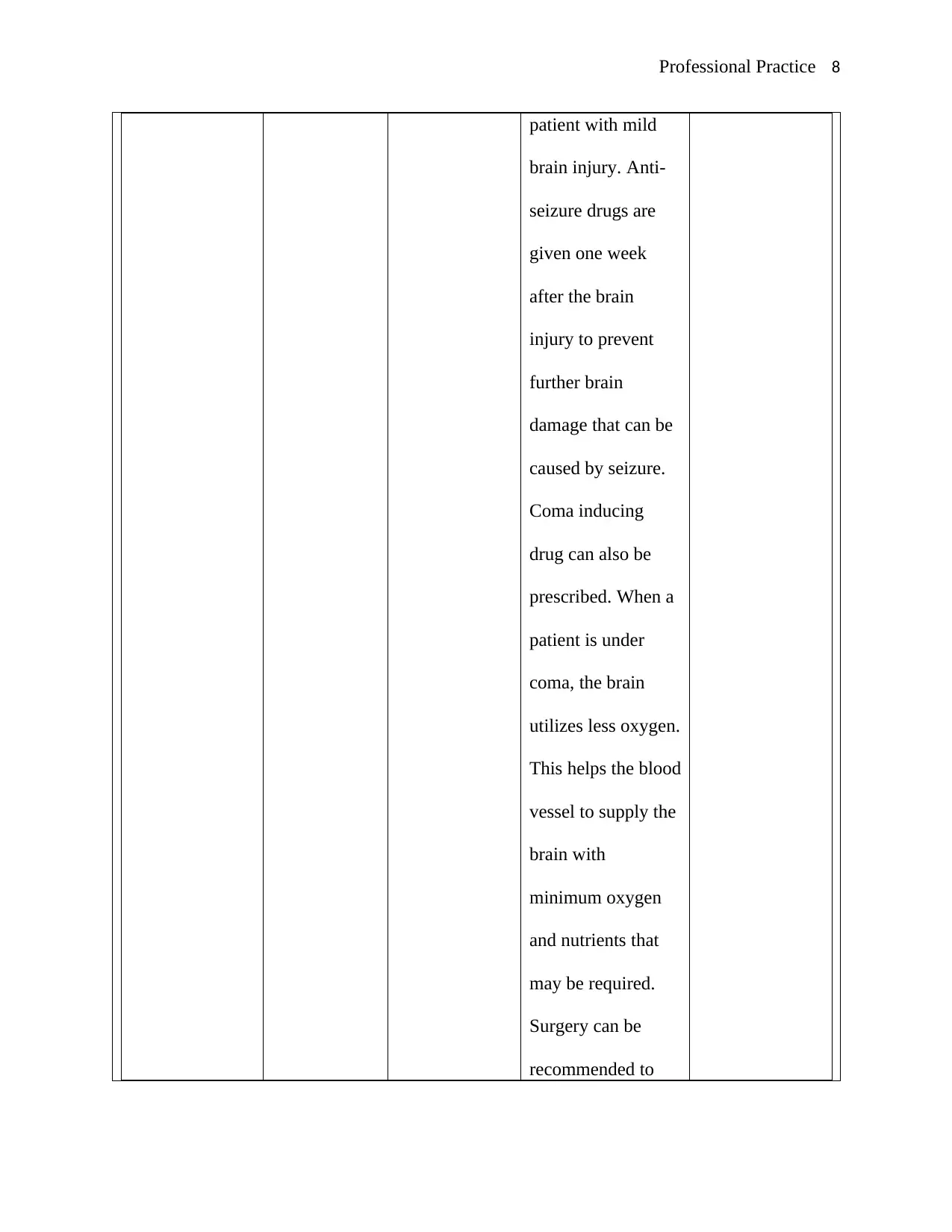
Professional Practice 8
patient with mild
brain injury. Anti-
seizure drugs are
given one week
after the brain
injury to prevent
further brain
damage that can be
caused by seizure.
Coma inducing
drug can also be
prescribed. When a
patient is under
coma, the brain
utilizes less oxygen.
This helps the blood
vessel to supply the
brain with
minimum oxygen
and nutrients that
may be required.
Surgery can be
recommended to
patient with mild
brain injury. Anti-
seizure drugs are
given one week
after the brain
injury to prevent
further brain
damage that can be
caused by seizure.
Coma inducing
drug can also be
prescribed. When a
patient is under
coma, the brain
utilizes less oxygen.
This helps the blood
vessel to supply the
brain with
minimum oxygen
and nutrients that
may be required.
Surgery can be
recommended to
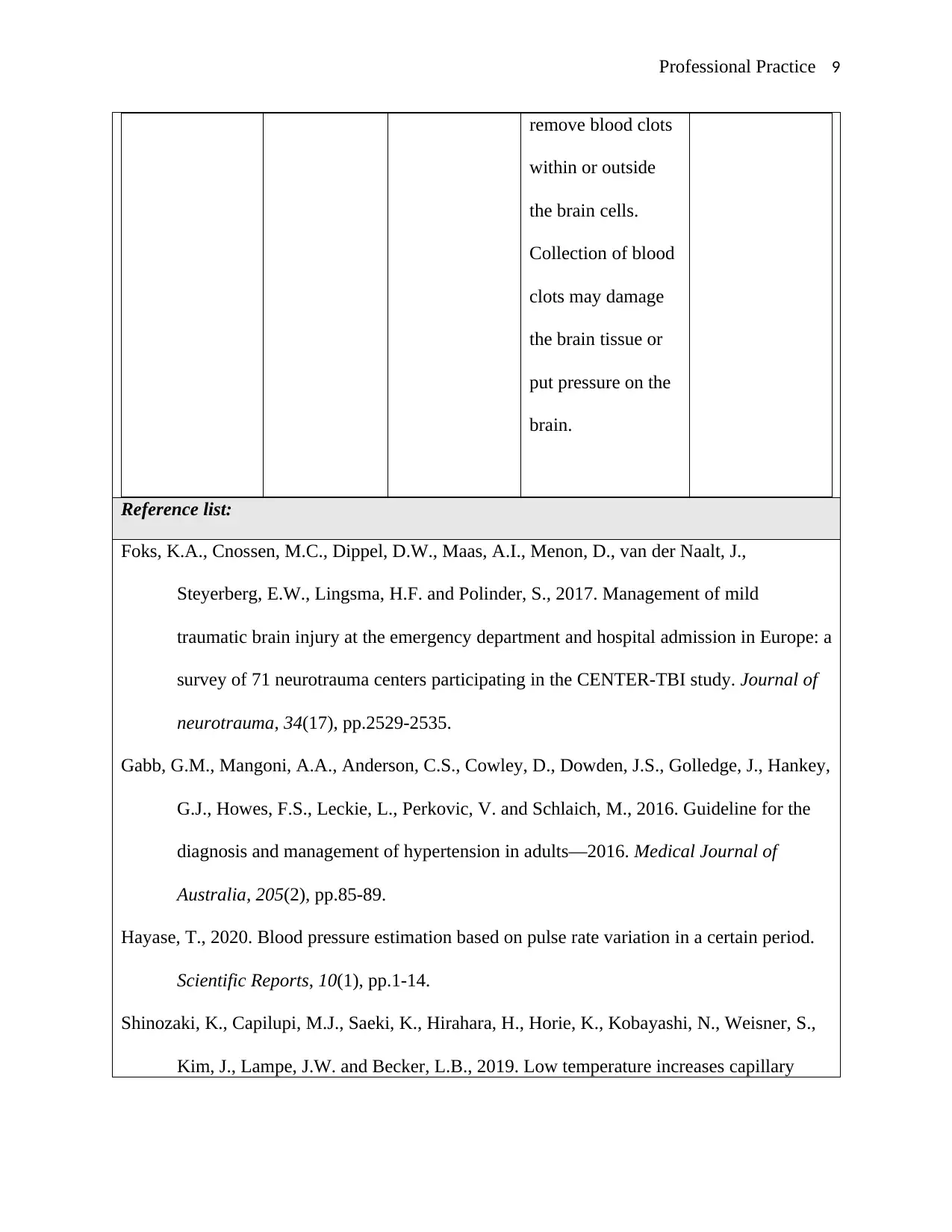
Professional Practice 9
remove blood clots
within or outside
the brain cells.
Collection of blood
clots may damage
the brain tissue or
put pressure on the
brain.
Reference list:
Foks, K.A., Cnossen, M.C., Dippel, D.W., Maas, A.I., Menon, D., van der Naalt, J.,
Steyerberg, E.W., Lingsma, H.F. and Polinder, S., 2017. Management of mild
traumatic brain injury at the emergency department and hospital admission in Europe: a
survey of 71 neurotrauma centers participating in the CENTER-TBI study. Journal of
neurotrauma, 34(17), pp.2529-2535.
Gabb, G.M., Mangoni, A.A., Anderson, C.S., Cowley, D., Dowden, J.S., Golledge, J., Hankey,
G.J., Howes, F.S., Leckie, L., Perkovic, V. and Schlaich, M., 2016. Guideline for the
diagnosis and management of hypertension in adults—2016. Medical Journal of
Australia, 205(2), pp.85-89.
Hayase, T., 2020. Blood pressure estimation based on pulse rate variation in a certain period.
Scientific Reports, 10(1), pp.1-14.
Shinozaki, K., Capilupi, M.J., Saeki, K., Hirahara, H., Horie, K., Kobayashi, N., Weisner, S.,
Kim, J., Lampe, J.W. and Becker, L.B., 2019. Low temperature increases capillary
remove blood clots
within or outside
the brain cells.
Collection of blood
clots may damage
the brain tissue or
put pressure on the
brain.
Reference list:
Foks, K.A., Cnossen, M.C., Dippel, D.W., Maas, A.I., Menon, D., van der Naalt, J.,
Steyerberg, E.W., Lingsma, H.F. and Polinder, S., 2017. Management of mild
traumatic brain injury at the emergency department and hospital admission in Europe: a
survey of 71 neurotrauma centers participating in the CENTER-TBI study. Journal of
neurotrauma, 34(17), pp.2529-2535.
Gabb, G.M., Mangoni, A.A., Anderson, C.S., Cowley, D., Dowden, J.S., Golledge, J., Hankey,
G.J., Howes, F.S., Leckie, L., Perkovic, V. and Schlaich, M., 2016. Guideline for the
diagnosis and management of hypertension in adults—2016. Medical Journal of
Australia, 205(2), pp.85-89.
Hayase, T., 2020. Blood pressure estimation based on pulse rate variation in a certain period.
Scientific Reports, 10(1), pp.1-14.
Shinozaki, K., Capilupi, M.J., Saeki, K., Hirahara, H., Horie, K., Kobayashi, N., Weisner, S.,
Kim, J., Lampe, J.W. and Becker, L.B., 2019. Low temperature increases capillary
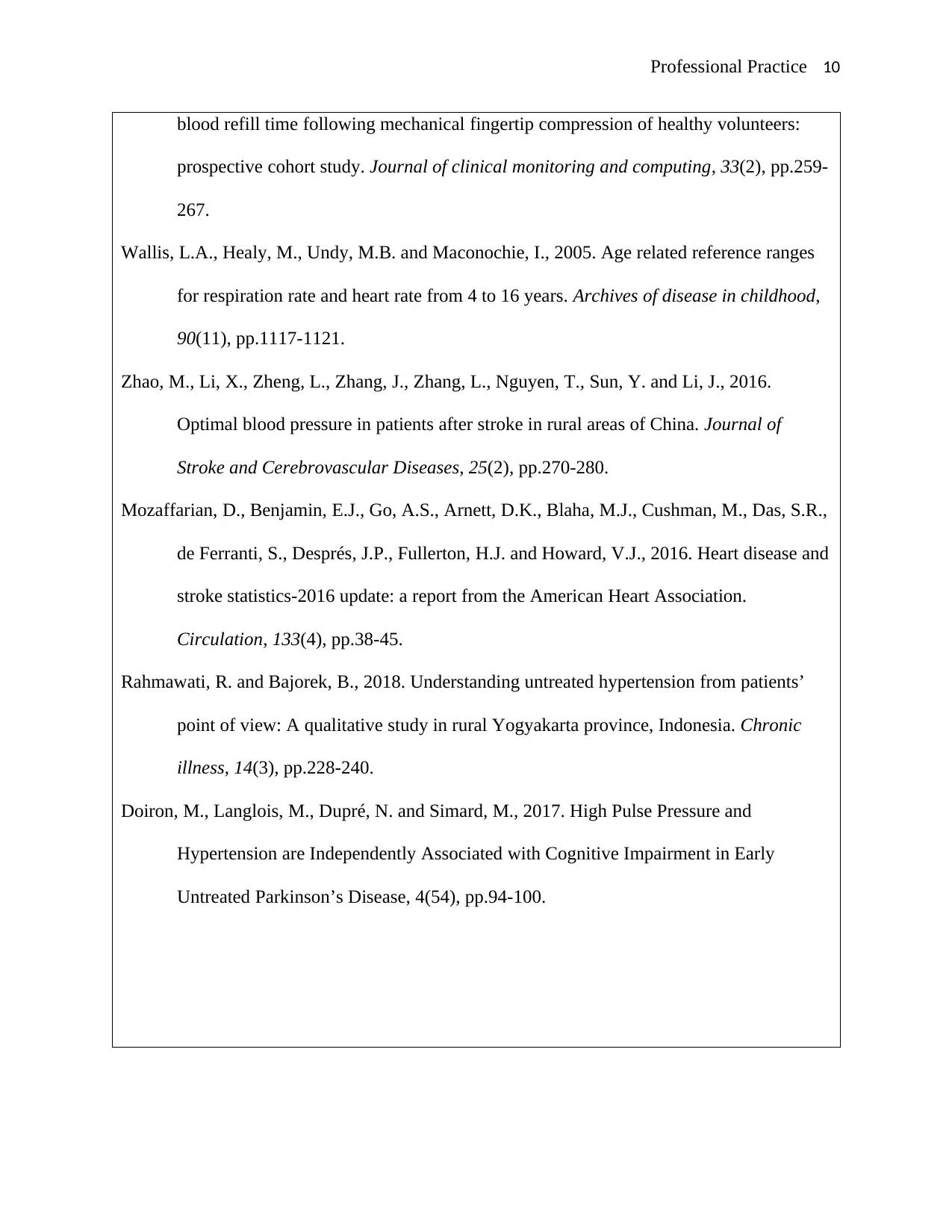
Professional Practice 10
blood refill time following mechanical fingertip compression of healthy volunteers:
prospective cohort study. Journal of clinical monitoring and computing, 33(2), pp.259-
267.
Wallis, L.A., Healy, M., Undy, M.B. and Maconochie, I., 2005. Age related reference ranges
for respiration rate and heart rate from 4 to 16 years. Archives of disease in childhood,
90(11), pp.1117-1121.
Zhao, M., Li, X., Zheng, L., Zhang, J., Zhang, L., Nguyen, T., Sun, Y. and Li, J., 2016.
Optimal blood pressure in patients after stroke in rural areas of China. Journal of
Stroke and Cerebrovascular Diseases, 25(2), pp.270-280.
Mozaffarian, D., Benjamin, E.J., Go, A.S., Arnett, D.K., Blaha, M.J., Cushman, M., Das, S.R.,
de Ferranti, S., Després, J.P., Fullerton, H.J. and Howard, V.J., 2016. Heart disease and
stroke statistics-2016 update: a report from the American Heart Association.
Circulation, 133(4), pp.38-45.
Rahmawati, R. and Bajorek, B., 2018. Understanding untreated hypertension from patients’
point of view: A qualitative study in rural Yogyakarta province, Indonesia. Chronic
illness, 14(3), pp.228-240.
Doiron, M., Langlois, M., Dupré, N. and Simard, M., 2017. High Pulse Pressure and
Hypertension are Independently Associated with Cognitive Impairment in Early
Untreated Parkinson’s Disease, 4(54), pp.94-100.
blood refill time following mechanical fingertip compression of healthy volunteers:
prospective cohort study. Journal of clinical monitoring and computing, 33(2), pp.259-
267.
Wallis, L.A., Healy, M., Undy, M.B. and Maconochie, I., 2005. Age related reference ranges
for respiration rate and heart rate from 4 to 16 years. Archives of disease in childhood,
90(11), pp.1117-1121.
Zhao, M., Li, X., Zheng, L., Zhang, J., Zhang, L., Nguyen, T., Sun, Y. and Li, J., 2016.
Optimal blood pressure in patients after stroke in rural areas of China. Journal of
Stroke and Cerebrovascular Diseases, 25(2), pp.270-280.
Mozaffarian, D., Benjamin, E.J., Go, A.S., Arnett, D.K., Blaha, M.J., Cushman, M., Das, S.R.,
de Ferranti, S., Després, J.P., Fullerton, H.J. and Howard, V.J., 2016. Heart disease and
stroke statistics-2016 update: a report from the American Heart Association.
Circulation, 133(4), pp.38-45.
Rahmawati, R. and Bajorek, B., 2018. Understanding untreated hypertension from patients’
point of view: A qualitative study in rural Yogyakarta province, Indonesia. Chronic
illness, 14(3), pp.228-240.
Doiron, M., Langlois, M., Dupré, N. and Simard, M., 2017. High Pulse Pressure and
Hypertension are Independently Associated with Cognitive Impairment in Early
Untreated Parkinson’s Disease, 4(54), pp.94-100.
Secure Best Marks with AI Grader
Need help grading? Try our AI Grader for instant feedback on your assignments.

Professional Practice 11
1 out of 11
Related Documents
Your All-in-One AI-Powered Toolkit for Academic Success.
+13062052269
info@desklib.com
Available 24*7 on WhatsApp / Email
![[object Object]](/_next/static/media/star-bottom.7253800d.svg)
Unlock your academic potential
© 2024 | Zucol Services PVT LTD | All rights reserved.





